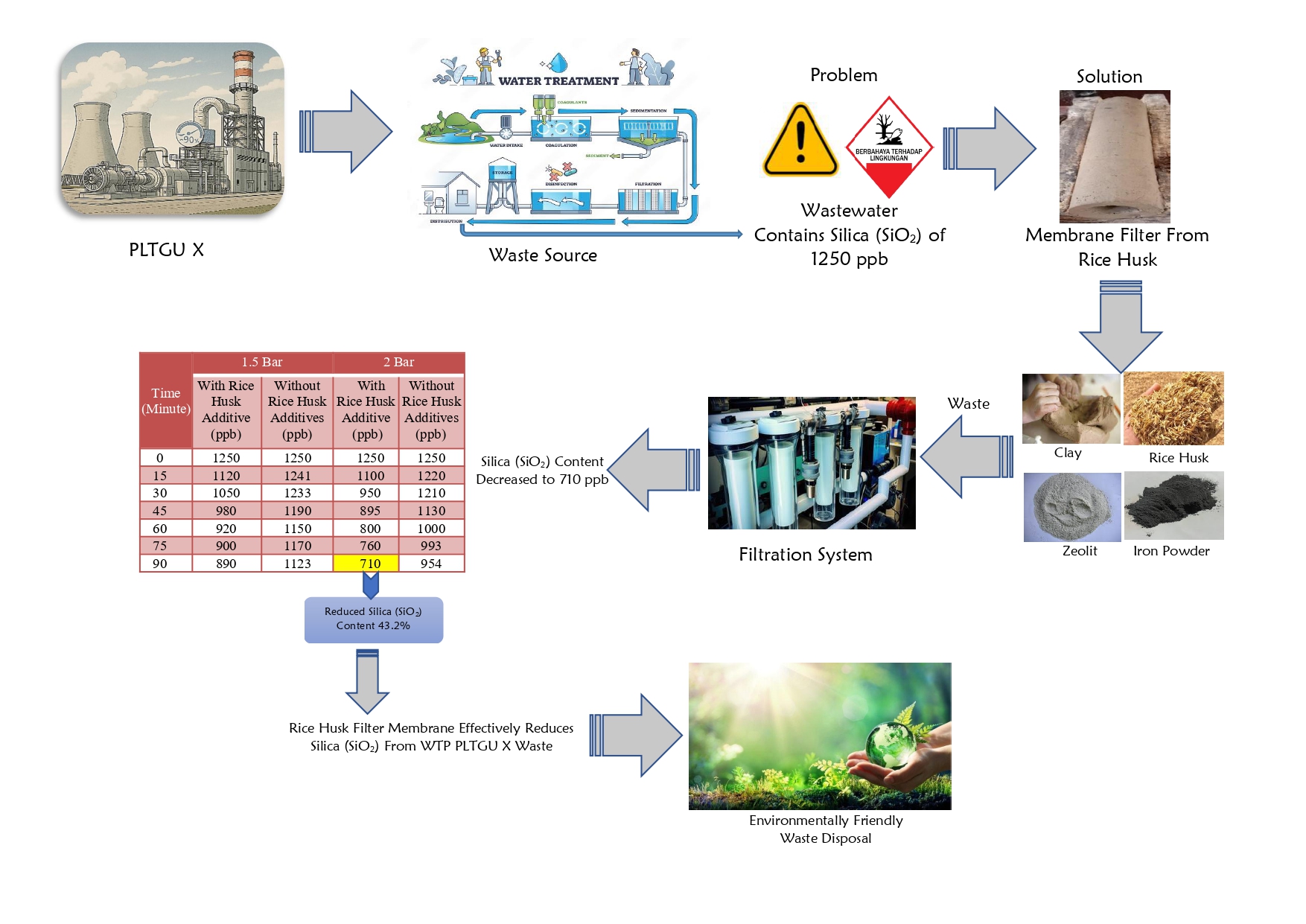Pengaruh pH dan Metabolisme Bakteri Escherichia coli dalam Reaktor Microbial Fuel Cell Terhadap Reduksi Kromium Heksavalen
Downloads
Kalimantan merupakan pulau yang terkenal akan sektor pertambangan salah satunya di daerah delta Mahakam, yang dalam proses eksploitasinya berpotensi menghasilkan limbah logam berat, seperti logam berat Cr6+. Pencemaran logam Cr6+ cukup sulit untuk terurai dilingkungan dan bersifat karsinogenik, karena dengan konsentrasi kecil saja dapat menimbulkan tingkat keracunan yang sangat tinggi pada makhluk hidup, sehingga pengolahan terhadap limbah tersebut sangat penting. Microbial Fuel Cell merupakan suatu metode yang dapat membantu proses pengolahan limbah dengan cara mereduksi Cr6+ menjadi Cr3+ dengan katalisis mikrobiologis. Penelitian ini menggunakan metode reaktor double-chamber yaitu terdapat ruang anoda yang berisi bakteri anaerob dan basic anolyte, sedangkan pada ruang katoda terdapat kalium dikromat dengan konsentrasi 18 mg/L dan variasi pH 3, 4 dan 5 yang dilakukan selama 10 hari. Kondisi pH optimum pada proses reduksi terjadi pada pH 4 dengan besar persen penurunan sekitar 98%. Dan produksi listrik tertinggi pada hari ke-2 pada variasi pH 3 dengan nilai power density sebesar sebesar 11, 06 mW/m2.
Downloads
Agustina, T. E., Faizal, M., Aprianti, T., Teguh, D., Aditya, M., Putra, I. G., Prayesi, M. R., Fitrializa, U. (2018). Pengolahan Limbah Logam Berat Kromium Hexavalen Menggunakan Reagen Fenton dan Adsorben Keramik Zeolit. Jurnal Rekayasa Kimia dan Lingkungan, 13(1), 60-69.
Asmadi, Endro, S., & Oktiawan, W. (2009). Pengurangan Chrom (Cr) dalam Limbah Cair Industri Kulit pada Proses Tannery Menggunakan Senyawa Alkali Ca(OH)2, NaOH dan NaHCO3 (Studi Kasus PT. Trimulyo Kencana Mas Semarang). Jurnal AI, 5(1), 41-54.
Darlan, Yudi, Kamiludin, Udayana, Arifin, L. (2009). Daerah Kasus Delta Mahakam Kalimantan Timur. Jurnal Geologi Kelautan, 7(236), 23-29.
Fikri, M. (2011). Microbial Fuel Cell, Energi Alterntif dari Bakteri. Bandung: ITB News
Gude, V. G. (2016). Wastewater treatment in microbial fuel cells - An overview. Journal of Cleaner Production. https://doi.org/10.1016/j.jclepro.2016.02.022
Jadhav, G. S., & Ghangrekar, M. M. (2009). Performance of microbial fuel cell subjected to variation in pH, temperature, external load and substrate concentration. Bioresour Technol, 100(2), 717-723. doi: 10.1016/j.biortech.2008.07.041.
Kamau, J. M., Mbui, D. N., Mwaniki, J. M., Mwaura, F. B., and Kamau, G. N. (2017). Microbial Fuel Cells: Influence of External Resistors on Power, Current and Power Density. Journal of Thermodynamics & Catalysis, 08(01), 1-5. https://doi.org/10.4172/2157-7544.1000182
Padarauskas, A., Judžentiene, A., Naujalis, E., & Paliulionyte, V. (1998). On-line preconcentration and determination of chromium(VI) in waters by high-performance liquid chromatography using pre-column complexation with 1,5-diphenylcarbazide. Journal of Chromatography A, 808(1-2), 193-199. https://doi.org/10.1016/S0021-9673(98)00118-6
Rabaey, K., Ossieur, W., Verhaege, M., & Verstraete, W. (2005). Continuous microbial fuel cells convert carbohydrates to electricity. Water Science and Technology. https://doi.org/10.2166/wst.2005.0561
Silva, B., Figueiredo, H., Neves, I.C and Tavares, T. (2009). The Role of pH on Cr(VI) Reduction and Removal by Arthrobacter Viscosus, International Journal of Chemical and Biological Engineering, 2(2), : 100-103.
Sophia, A. C., & Sai, S. (2016). Modified microbial fuel cell for Cr(VI) reduction and simultaneous bio-electricity production. Journal of Environmental Chemical Engineering, 4(2), 2402-2409. https://doi.org/10.1016/j.jece.2016.04.025
Sophia, A. C., & Saikant, S. (2016). Reduction of chromium(VI) with energy recovery using microbial fuel cell technology. Journal of Water Process Engineering, 11, 39-45. https://doi.org/10.1016/j.jwpe.2016.03.006
Sun, G., Thygesen, A., & Meyer, A. S. (2015). Acetate is a superior substrate for microbial fuel cell initiation preceding bioethanol effluent utilization. Applied Microbiology and Biotechnology, 99(11), 4905-4915. https://doi.org/10.1007/s00253-015-6513-5
Wang, H., Wang, Q., Li, X., Wang, Y., Jin, P., Zheng, Y., ... Qingbiao Li. (2019). Bioelectricity generation from the decolorization of reactive blue 19 by using microbial fuel cell. Journal of Environmental Management, 248(March), 109310. https://doi.org/10.1016/j.jenvman.2019.109310
Watson, V. J. (2013). Characterization and performance of activated carbon catalysts and polymer membrane layers for microbial fuel cell cathodes and an analysis of power overshoot. A Dissertation in Environmental Engineering, The Pennsylvania State University.
Xafenias, N., Zhang, Y., & Banks, C. J. (2013). Enhanced performance of hexavalent chromium reducing cathodes in the presence of Shewanella oneidensis MR-1 and lactate. Environmental Science and Technology, 47(9), 4512-4520. https://doi.org/10.1021/es304606u
Copyright (c) 2019 CHEESA: Chemical Engineering Research Articles

This work is licensed under a Creative Commons Attribution-NonCommercial-ShareAlike 4.0 International License.
With the receipt of the article by CHEESA Editorial Board and the decision to be published, the copyright regarding the article will be transferred to CHEESA Journal.
CHEESA has the right to multiply and distribute the article and every author is not allowed to publish the same article that was published in this journal.

This work is licensed under a Creative Commons Attribution-NonCommercial-ShareAlike 4.0 International License.
Under the following terms:
Attribution ” You must give appropriate credit, provide a link to the license, and indicate if changes were made. You may do so in any reasonable manner, but not in any way that suggests the licensor endorses you or your use.
NonCommercial ” You may not use the material for commercial purposes.
ShareAlike ” If you remix, transform, or build upon the material, you must distribute your contributions under the same license as the original.







